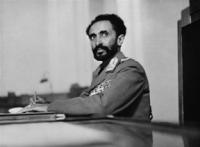
Emperor Haile Selassie I in his study in the Imperial Palace in the Ethiopian capital of Addis Ababa in 1942
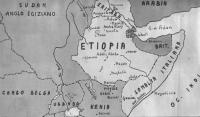
Africa Orientale Italiana
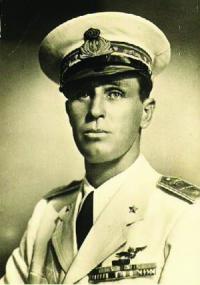
Gov.-Gen. Africa Orientale Italiana, Prince Amadeo, Duke of Aosta
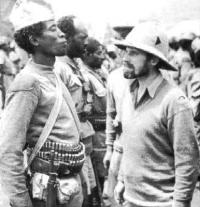
Orde Wingate inspecting soldiers of "Gideon Force"
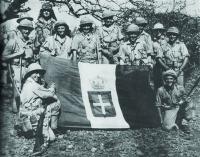
South African soldiers after the occuparion of Moyale, February 22, 1941
This month, seventy years ago, Commonwealth forces under the command of British General Sir Alan Cunningham liberated the Ethiopian capital of Addis Ababa, while the Fifth Indian Division, under the command of Maj.-General Sir Lewis Heath captured the Eritrean capital of Asmara.
Italian East Africa - Africa Orientale Italiana - was cobbled together from Eritrea, Italian Somalia, Ethiopia and, in 1940, for a few months, British Somaliland. Eritrea became the first Italian Colony, in the 19th Century. By the time World War II arrived, nearly one hundred thousand Italians lived in the Colony. The capital, Asmara, had a population of 98,000, of which more than half were Italians, and was nicknamed Piccola Roma - “Little Rome.” The second piece of African Orientale Italiana was Italian Somaliland which the Italians had been colonizing since the late 19th Century. By the time war came there were 22,000 Italians living in Somalia, with half of them living in the capital of Mogadishu.
In October 1935, the Italians launched a two-prong invasion of Ethiopia. From Eritrea, forces under the command of General Emilio De Bono, and from Somaliland, forces under the command of General Rodolfo Graziani, attacked. By May Ethiopia had been conquered and Emperor Haile Selassie I fled to England. Ethiopia became the third piece of the Africa Orientale Italiana and King Victor Emmanuel III was declared Emperor of the new Italian Empire. When the Kingdom of Italy entered the War against Great Britain, the British Colony of British Somaliland became a target, as did the surrounding British Colonies of Kenya and Sudan.
Almost immediately after the Italian Declaration of War, Emperor Selassie flew to Alexandria, Egypt, and then to Khartoum, capital of the Sudan, where he met with Lieutenant General William Platt, Commandant of the Sudan Defense Force. In October the two met with British Foreign Secretary, Anthony Eden, South African General Jan Smuts, General Sir Archibald Wavell, Commander-In-Chief of the Middle East Command, and Lieutenant General Alan Cunningham, to plan the conquest of Africa Orientale Italiana and the Emperor’s return to his throne.
In July, Italian Forces from Eritrea crossed the border with Sudan and captured the railway junction of Kassala, which is the capital of the Sudanese state of the same name. Currently there is no railroad, but it has a population in excess of 400,000. This was the second time the Italians had captured the city, having captured it in 1894. The British fort at Gallabat and the Villages of Ghezzan, Kurmuk and Dumbode, on the Blue Nile, were also captured. In the South the Italians invaded Kenya and captured Fort Harrington at Moyale, and the villages of Dabel and Buna. Moyale is a town located on the Ethiopian/Kenyan border. Today, the Ethiopian part has a population of about 25,000, while the Kenyan part has a population of about 10,000.
In August, Italian Forces invaded British Somaliland and forced the Commonwealth Forces to evacuate. They would have invaded French Somaliland - now known as Djibouti - as well, had not France executed an armistice on June 24, 1940 with the Italian Kingdom.
During the Italian colonial period, the area was modernized and conditions greatly improved. The Italians built 11,678 miles of paved roads and laid 559 miles of railways. State-of-the-art roads connected the provincial capitals of Asmara and Mogadishu with Addis Ababa.
On November 6, 1940, the 10th Infantry Indian Brigade, under the command of William Slim, recaptured Gallabat in a surprise, early-morning attack. Over the next three days planes of the Regia Aeronautica Italiana mounted such a fierce counter-assault that the Commonwealth forces were compelled to retire and Italian forces once again occupied the position.
In January 1941, Orde Wingate and a group of Ethiopian and Sudanese soldiers, which Wingate dubbed “Gideon Force,” crossed the Ethiopian border and began “irregular” activities in Ethiopia’s Gojjam province. The Ethiopian Emperor joined them on January 18,1941. Wingate would later earn fame, in the jungles of Burma, at the head of the “Chindits.”
In the meantime, Commonwealth forces under General Cunningham crossed the Kenyan border into Somaliland and another force, commanded by Lt. General William Platt advanced south into Eritrea, from Sudan.
The assault on the Italian stronghold of Keren, in Eritrea, began on February 1, 1941. Today, Keren has a population of about 90,000 and is the second largest city in the country and the capital of Anseba Province. Keren was the key to the Eritrean capital of Asmara and its biggest and best Red Sea port Massawa. If the Italians could hold Keren, the Allies might be prevented from going further. The Commonwealth forces included the Fourth and Fifth Indian Divisions, commanded by, respectively, Maj. Generals Sir Noel Beresford-Peirse and Lewis Heath. Later, the 13th French Foreign Legion Demi-Brigade, commanded by Colonel Ralph Monclar was added.
Lt. General Nicolangelo Carnimeo commanded the defenders, which included the First Colonial Division, two regiments of Savoia Grenadiers and an Alpini battalion. General Wavell told Prime Minister Churchill that, “Keren is proving itself a tough nut to crack. The enemy is ferociously and repeatedly counterattacking us, and even if its losses have been exceedingly heavy, there’s no immediate sign of yielding.” Not until March 27, was it finally captured.
The Commonwealth Forces sustained 4,000 casualties, of which 536 were killed, while the Italians sustained more than 3,000 dead. The survivors of Keren retreated to Adi Tekelezan, which was surrendered on April 1, 1941.
In his book, Eastern Epic, Scottish author Compton Mackenzie observed that,
“Keren was as hard a soldier’s battle as was ever fought, and let it be said that no where in the war did the Germans fight more stubbornly than those Savoia Battalions, Alpini, Bersaglieri and Grenadiers. In [the first] five days fight the Italians suffered nearly 5,000 casualties-1, 135 of them killed. [Orlando Lorenzini] the gallant, young Italian General, had his head blown off by one of the British guns. He had been a great leader of Eritrean troops.
The unfortunate license of wartime propaganda allowed the British Press to represent the Italians almost as comic warriors; but except for the German Parachute Division in Italy and the Japanese in Burma, no enemy with whom the British and Indian Troops were matched put up a finer fight than those Savoia Battalions at Keren. Moreover, the Colonial Troops, until they cracked at the very end, fought with valor and resolution, and their staunchness was a testimony to the excellence of the Italian Administration and military training in Eritrea.”
The big difference, in this battle, and for all of East Africa, was air power. The Italians had none. Although, they had some at one time, they were unable to import spare parts and replacements.
Meanwhile, in the south, General Cunningham’s forces, with support from the cruiser H.M.S. Shropshire, had captured the Indian Ocean port of Kismayo on February 14, 1941 and Mogadishu on February 25. After capturing Mogadishu, the Commonwealth troops advanced 600 miles into Eritrea before contacting the enemy at Dagabur. South African troops crossed the Ethiopian border from Kenya, and captured Mega and 1,000 prisoners on February 18. Four days later, they occupied Moyale, as well. Air strikes are launched from the British aircraft carrier H.M.S. Formidable against the Eritrean port city of Massawa, on the Red Sea on February 21. The Italians had created the largest and safest port on the east coast of Africa at Massawa. The R.A.F. bombed the Eritrean capital of Asmara on February 28.
On March 16, Commonwealth forces landed in British Somaliland and recaptured its capital of Berbera. Four days later, Hergeisa was recaptured and the seat of the government of British Somaliland transferred to that city.
On March 26th Harar in Ethiopia was captured. Today, it has a population of a little more than 100,000. Three days later Dire Dawa fell. Currently its population stands at 600,000.
Asmara was captured by Commonwealth forces led by Gen. Platt on April 1.
Emperor Haile Selassie I entered the Ethiopian city of Debre Marqos, which was the capital of the Ethiopian Province of Gojjam, on April 6, 1941, where he was greeted by Major Wingate.
Italian forces, under the command of Rear Admiral Mario Bonnetti, defending, Massawa surrendered, on April 8 to the 13th French Foreign Legion Demi-Brigade, commanded by Colonel Ralph Monclar. Under the Italians, the port had become the largest and safest on the east coast of Africa and was home to the Regia Marina’s Red Sea Flotilla, which included six destroyers and seven submarines.
The Italian garrison of the Ethiopian City of Dessie surrendered to 1st South African Brigade commanded by Brigadier-General Daniel Pienaar on April 20, 1941. 8,000 prisoners are taken.
The siege of Amba Alagi began on May 3 when troops of the Indian Fifth Infantry Division, now under the command of Major General Sir Mosley Mayne, began their assault. Amba Alagi was a 12,000-foot high mountain between the Ethiopian capital of Addis Ababa and Asmara. The Italians had fortified the solid rock, stocking it with ample ammunition and stores. The Duke of Aosta would, himself, command the defenders. He was a cousin of King Victor Emmanuel, III and was the brother of Admiral Prince Aimone of Savoy-Aosta, Duke of Spoleto, whom the King, on May 18, 1941, had named the King of Croatia. The Duke was the Governor-General of Africa Orientale Italiana.
The Duke’s forces consisted of 500 regular army, 3,000 colonial troops, Caribinieri (Italian national police), airmen and sailors from the naval base at Assab.
On May 11th the Indians were joined by Brigadier General Pienaar’s South African Brigade. By May 14th the Italian position at Amba Alagi was surrounded by 9,000 Commonwealth forces and 20,000 Ethiopian “irregulars.” When a fortuitous artillery shell hit an Italian fuel dump and ruptured one of the vessels containing oil causing it to flow into the remaining drinking water, the jig was up. On May 14, the Duke received permission from Il Duce to surrender and on May 18th he surrendered to General Mayne, who allowed a surrender with full military honors. Italian casualties in Africa Orientale Italiana numbered 230,000 killed or captured.
The Duke, who by all accounts was a first-class gentleman, died in a British prison camp, in Thika, Kenya, on March 3, 1942, after contracting malaria and tuberculosis. Because of his royal relations, the British offered to allow him to sit out the war in London, but he refused, preferring to stay with his troops. He was 43. He is buried in the Italian War Memorial Church in the Kenyan town of Nyeri, near the River Chania. He is joined by 676 other Italian soldiers who died fighting in Africa Orientale Italiana. Outside the Church are buried colonial troops who also died in the fighting there. Mass is celebrated there once a year, in November.
Ethiopian Emperor Haile Selassie I entered the Ethiopian capital of Addis Ababa on May 5. It had been exactly five years since the Italians had captured the city. May 5 is now a national holiday in Ethiopia.
Soddu, in southern Ethiopia, was captured by 11th & 12th African Divisions on May 24.
Only three positions remained under Italian control: the Eritrean port city of Assab, on the Southern Red Sea, which today has a population of about 35,000; Gondar, the third largest city in Ethiopia, in the Northern part of the country, which today has a population of about 200,000; and Jimma, in the Western part of Ethiopia, which has a population of about 160,000.
On June 11th Assab fell. It was the last Red Sea port held by the Italians. The Italian forces at Jimma were commanded by General Pietro Gazzera, who was now, since the surrender of the Duke of Aosta, the acting Viceroy and Governor-General of the remnants of Africa Orientale Italiana. On July 3rd he surrendered his garrison of 15,000 to Belgian Major General Augusté-Éduard Gilliaert.
This left Gondar, whose forces were commanded by General Guglielmo Nasi, who after General Gazzera surrendered, became the new acting Viceroy and Governor-General. General Nasi had commanded the Italian forces which pushed the British out of British Somaliland the previous summer. Finally, on November 27, 1941 General Nasi and his 23,500-man garrison surrendered to Maj.-Gen. Charles Fowkes, commander of 12th (East African) Division.
Approximately 7,000 Italians continued a guerilla war in the desserts of Eritrea and Somalia and in the forests and mountains of Ethiopia. Once the Kingdom of Italy surrendered, in September of 1943, the guerilla war ended as well.
With the Red Sea and Gulf of Aden cleared of Axis forces, President Roosevelt was able to declare them no longer combat zones, allowing American merchant ships to sail in those areas, and therefore provide much relief to the British merchant fleet and speed the flow of arms and materiel to Commonwealth forces in North Africa.
NEXT: THE INVASION OF IRAQ
Mr. Wimbrow writes from Ocean City, Maryland, where he practices law representing those persons accused of criminal and traffic offenses, and those persons who have suffered a personal injury through no fault of their own.
«Go back to the previous page.




